Diferencia entre revisiones de «Fuerza Aérea de los Estados Unidos»
Revertidos los cambios de 200.56.156.155 a la última edición de Sorruno usando monobook-suite |
|||
| Línea 84: | Línea 84: | ||
[[File:A10Thunderbolt2 990422-F-7910D-517.jpg|thumb|right|[[A-10 Thunderbolt II]] [[ground attack aircraft]].]] |
[[File:A10Thunderbolt2 990422-F-7910D-517.jpg|thumb|right|[[A-10 Thunderbolt II]] [[ground attack aircraft]].]] |
||
The ground-attack aircraft of the USAF are designed to attack targets on the ground and are often deployed as close air support for, and in proximity to, U.S. ground forces. The proximity to friendly forces require precision strikes from these aircraft that are not possible with bomber aircraft listed below. They are typically deployed as close air support to ground forces, their role is tactical rather than strategic, operating at the front of the battle rather than against targets deeper in the enemy's rear. |
|||
El terreno de los aviones de la USAF están diseñados para atacar objetivos en tierra y estos a menudo adoptan la forma de apoyo aéreo, y en proximidad a los EE.UU. las fuerzas de tierra. La proximidad a fuerzas amigas exigen precisión las huelgas de estos aviones que no son posibles con los aviones bombarderos se enumeran a continuación. Que normalmente se despliegan como apoyo aéreo a las fuerzas de tierra, su papel es estratégico y no táctico, operativo en el frente de la batalla en lugar de objetivos más profundos en contra del enemigo |
|||
* [[A-10 Thunderbolt II|A-10A/C Thunderbolt II]] |
* [[A-10 Thunderbolt II|A-10A/C Thunderbolt II]] |
||
Revisión del 23:06 3 jul 2009
Plantilla:Infobox Unidad Militar
La Fuerza Aérea de los Estados Unidos, en inglés United States Air Force (USAF), es la rama de aviación de las Fuerzas Armadas de los Estados Unidos de América. A fecha de septiembre de 2006, está compuesta por 334.200 soldados de aviación, 120.369 de la guardia nacional del aire y 107.000 como reserva nacional del aire.
Misión
1. De acuerdo al Acta de Seguridad Nacional de 1947, en inglés (61 Stat. 502) que creaba la "Fuerza Aerea":
En general la Fuerza Aérea de Estados Unidos incluirá fuerzas de aviación tanto de combate como de servicio sin asignación específica. Se organizará, entrenará, y equipará primariamente para operaciones aéreas ofensivas y defensivas prontas y sustantivas. La Fuerza Aérea será responsable de la preparación de las fuerzas aéreas necesarias para la prosecución efectiva de guerra, excepto cuando haya otras asignaciones y, de acuerdo con los planes integrados de movilización, con la expansión de los componentes en tiempo de paz de la Fuerza Aérea para alcanzar las necesidades de la guerra.
Cronología
- 1941-45 Segunda Guerra Mundial como las Fuerzas Aéreas del Ejército de los Estados Unidos (United States Army Air Force (USAAF)).
- 1947-91 Mantener el equilibrio del terror con bombarderos de las bombas atómicas y según misiles balísticos en la guerra fría.
- 1948-49 Operation Vittles, el puente aéreo en Berlín Oeste.
- 1950-53 Apoyó aéreo a las fuerzas de tierra la O.N.U. en la guerra de Corea.
- 1964-73 Guerra de Vietnam.
- 1973 Operation Nickel Grass, entrega de armas por puente aéreo a Israel en la guerra de Yom Kipur.
- 1979 Operation Eagle Claw, misión abortada para liberar los rehenes estadounidenses en Irán.
- 1986 Operation El Dorado Canyon, bombardeo en Libia.
- 1990-91 Operación Escudo del desierto, protección a Arabia Saudí contra Iraq.
- 1991 Operación Tormenta del desierto contra Irak.
- 1991-96 Operation Provide Comfort, mantenera de la zona de exclusión aérea al norte de la 36° de latitud norte en Irak.
- 1991-2003 Operation Southern Watch, mantenera de la zona de exclusión aérea al sur de la 33° de latitud norte en Irak.
- 1993-95 Operation Deny Flight, mantenera de la zona de exclusión aérea en Bosnia y Hercegovina.
- 1995 Operación Deliberate Force, bombardeos en Bosnia y Hercegovina.
- 1996 Operation Desert Strike, bombardeos en Irak.
- 1997-2003 Operation Northern Watch, mantenera de la zona de exclusión aérea al norte de la 36° de latitud norte en Irak.
- 1998 Operation Desert Fox, bombardeos en Irak.
- 1999 Operación Allied Fuerza, bombardeos en Serbia, en la guerra de Kosovo.
- 2001-récent Operation Enduring Freedom, bombardeos en Afganistán.
- 2003-04 Operation Iraqi Freedom, invasión de Irak.
Organización
- Comando Aéreo de Combate (Air Combat Command)
- Comando Aéreo de Educación y Formación (Air Education and Training Command)
- Comando Aéreo de Objetivos Globales (Air Force Global Strike Command)
- Comando Aéreo de Material (Air Force Materiel Command)
- Comando Aéreo de la Reserva (Air Force Reserve Command)
- Comando Aéreo Espacial (Air Force Space Command)
- Comando Aéreo de Operaciones Especiales (Air Force Special Operations Command)
- Comando Aéreo de Movilización (Air Mobility Command)
- Fuerzas Aéreas de Estados Unidos en Europa (United States Air Forces in Europe)
- Fuerzas Aéreas de Estados Unidos en el Pacífico (Pacific Air Forces)
The United States Air Force has over 5,778 aircraft commissioned as of 2004. Until 1962, the Army and Air Force maintained one system of aircraft naming, while the U.S. Navy maintained a separate system. In 1962, these were unified into a single system heavily reflecting the Army/Air Force method. For more complete information on the workings of this system, refer to United States Department of Defense aerospace vehicle designation. The various aircraft of the Air Force include:
A - Ataque a tierra
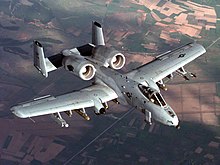
The ground-attack aircraft of the USAF are designed to attack targets on the ground and are often deployed as close air support for, and in proximity to, U.S. ground forces. The proximity to friendly forces require precision strikes from these aircraft that are not possible with bomber aircraft listed below. They are typically deployed as close air support to ground forces, their role is tactical rather than strategic, operating at the front of the battle rather than against targets deeper in the enemy's rear.
B - Bombarderos

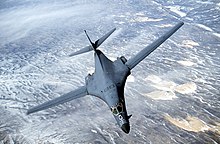
In the US Air Force, the distinction between bombers, fighter-bombers, and attack aircraft has become blurred. Many attack aircraft, even ones that look like fighters, are optimized to drop bombs, with very little ability to engage in aerial combat. Many fighter aircraft, such as the F-16, are often used as 'bomb trucks,' despite being designed for aerial combat. Perhaps the one meaningful distinction at present is the question of range: a bomber is generally a long-range aircraft capable of striking targets deep within enemy territory, whereas fighter bombers and attack aircraft are limited to 'theater' missions in and around the immediate area of battlefield combat. Even that distinction is muddied by the availability of aerial refueling, which greatly increases the potential radius of combat operations. The US is the only country, besides Russia, that operates strategic bombers.
The majority of the USAF's dedicated bombers are rapidly aging. The B-52 Stratofortress airframe is over 50 years old, and are scheduled to remain in service for another 30 years, which would keep the airframe in service for over 90 years, an unprecedented length of service for any aircraft. Plans for successors to the current strategic bomber force remain only paper projects, and political and funding pressures suggest that they are likely to remain paper-bound for the foreseeable future.
C - Transporte de Carga
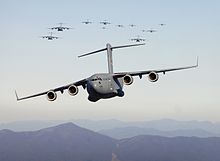
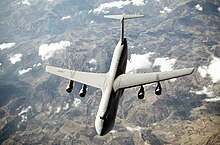

The Air Force can provide rapid global mobility, which lies at the heart of U.S. strategy in this environment--without the capability to project forces, there is no conventional deterrent. As U.S. forces stationed overseas continue to decline, global interests remain, making the unique mobility capabilities of the USAF even more in demand. Air mobility is a national asset of growing importance for responding to emergencies and protecting American interests around the globe.
Cargo and transport aircraft are typically used to deliver troops, weapons and other military equipment by a variety of methods to any area of military operations around the world, usually outside of the commercial flight routes in uncontrolled airspace. The workhorses of the USAF Air Mobility Command are the C-130 Hercules, C-17 Globemaster III, and C-5 Galaxy. These aircraft are largely defined in terms of their range capability as strategic airlift (C-5), strategic/tactical (C-17), and tactical (C-130) airlift to reflect the needs of the land forces which they most often support. The CV-22 is used by the Air Force for the U.S. Special Operations Command (USSOCOM). It conducts long-range, special operations missions, and is equipped with extra fuel tanks and terrain-following radar.
- C-5A/B/C/M Galaxy
- C-12C/D/F Huron
- C-17A Globemaster III
- C-20A/B/C Gulfstream III
- C-20G/H Gulfstream IV
- C-21A Learjet
- C-27J Spartan
- C-37A/B Gulfstream V
- C-38A Courier
- C-40B Clipper
- C-41A Aviocar
- C-130E/H Hercules
- C-130J Super Hercules
- CV-22B Osprey
E - Misiones electrónicas especiales
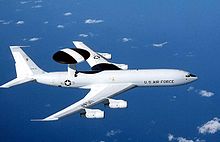
The purpose of electronic warfare is to deny the opponent an advantage in the EMS and ensure friendly, unimpeded access to the EM spectrum portion of the information environment. Electronic warfare aircraft are used to keep airspaces friendly, and send critical information to anyone who needs it. They are often called "The Eye in the Sky."
F - Combate


The fighter aircraft of the USAF are small, fast, and maneuverable military aircraft primarily used for air-to-air combat. Many of these fighters have secondary ground-attack capabilities, and some are dual-roled as fighter-bombers (e.g., the F-16 Fighting Falcon); the term "fighter" is also sometimes used colloquially for dedicated ground-attack aircraft. Other missions include interception of bombers and other fighters, reconnaissance, and patrol. Out of the 5,778 manned aircraft in service, 2,402 are fighters, and 1,245 of those are variants of the F-16 Fighting Falcon.
H - Búsqueda y rescate, evacuación médica
Estos aparatos son usados para búsqueda y rescate sobre tierra.
K - Cisterna
The USAF's aerial refueling aircraft are derivatives of civilian jets. Usually, the aircraft providing the fuel is specially designed for the task, although refueling pods can be fitted to existing aircraft designs if the "probe and drogue" system is to be used. There is no known regular civilian in-flight refueling activity. In large-scale operations (and even daily air operations), air-to-air refueling is extensively used; fighters, bombers, and cargo aircraft rely heavily on the lesser-known "tanker" aircraft. This makes these aircraft an essential part of the Air Force's global mobility and the U.S. force projection.
L - Equipados ocn láser

Airborne Laser (ABL) weapons system with a megawatt-class chemical oxygen iodine laser (COIL) mounted inside a modified Boeing 747-400F. It is primarily designed as a missile defense system to destroy tactical ballistic missiles (TBMs) in boost phase.
M - Multi-misión
Specialized mutli-mission aircraft provide support for global special operations missions. These aircraft conduct infiltration, exfiltration, resupply, and refueling for SOF teams from improvised or otherwise short runways.
UAVs multimisión
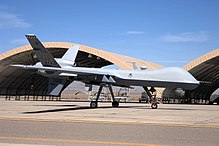
Initial generations of UAVs were primarily surveillance aircraft, but some were fitted with weaponry (such as the MQ-1 Predator, which utilized AGM-114 Hellfire air-to-ground missiles). An armed UAV is known as an unmanned combat air vehicle (UCAV).
O - Observación
These aircraft are modified to observe (through visual or other means) and report tactical information concerning composition and disposition of forces.
R - Reconocimiento
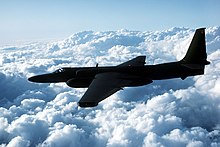
The reconnaissance aircraft of the USAF are used for monitoring enemy activity, originally carrying no armament. Several unmanned remotely-controlled reconnaissance aircraft (UAVs) have been developed and deployed. Recently, the UAVs have been seen to offer the possibility of cheaper, more capable fighting machines that can be used without risk to aircrews.
Note: Although the U-2 is designated as a 'utility' aircraft, it is indeed a reconnaissance platform.
- RC-26B
- RC-135S/U/V/W Combat Ball/Combat Sent/Combat Sent/Rivet Joint
- RQ-4A Global Hawk
- RQ-11 Raven
- U-2R/S "Dragon Lady"
T - Entrenamiento
The Air Force's trainer aircraft are used to train pilots, navigators, and other aircrew in their duties.
U - Utilitarios
Utility aircraft are used basically for what they are needed for at the time. For example, a Huey may be used to transport personnel around a large base or launch site, while it can also be used for evacuation. These aircraft are all around use aircraft.
V - Transporte VIP
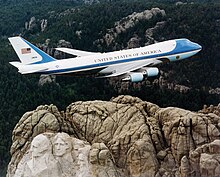
These aircraft are used for the transportation of Very Important Persons. Notable people include the President, Vice President, secretaries, government officials (e.g., senators and representatives), the Joint Chiefs of Staff, and other key personel.
W - Weather reconnaissance
These aircraft are used to study meteorological events such as hurricanes and typhoons.
- An-26 Curl (6th Special Operations Squadron)
- CN-235-100[1] (427th Night Fighter Squadron)
- Mi-8 (6th Special Operations Squadron)
Referencias
Enlaces externos
 Wikimedia Commons alberga una galería multimedia sobre Fuerza Aérea de los Estados Unidos.
Wikimedia Commons alberga una galería multimedia sobre Fuerza Aérea de los Estados Unidos.- Sitio oficial USAF, en inglés
- Sitio oficial USAF de Reclutamiento
- DoSomethingAmazing.com Otro sitio oficial de reclutamiento USAF
- Oficina de Historia USAF
- Agencia de Investigación Histórica USAF
- Museo Nacional USAF
- Joint Fires Integration and Interoperability Team works with all branches
- Emblemas USAF
